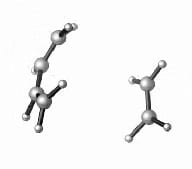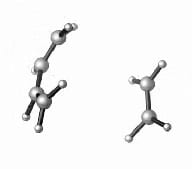
Early this year we commented on progress in designing an artificial enzyme to catalyze the Diels-Alder reaction, an important cycloaddition reaction in synthetic organic chemistry that had been proposed as one strategy to develop molecular building block for molecular manufacturing. A new understanding of exactly how the Diels-Alder reaction occurs validates computational methods that may lead to the ability to design a protein catalyst for whatever reaction is needed. A hat tip to ScienceDaily for reprinting this UCLA news release “New insights into how the most iconic reaction in organic chemistry really works“:
… Now, Kendall N. Houk, UCLA’s Saul Winstein Professor of Organic Chemistry, and colleagues report exactly how the Diels–Alder reaction occurs. Their research is published this week in the early online edition of the journal Proceedings of the National Academy of Sciences [abstract] and will be published in an upcoming print edition.
“We have examined the molecular dynamics of the Diels–Alder reaction, which has become the most important reaction in synthesis, in detail to understand how it happens,” said Houk, who is a member of the California NanoSystems Institute at UCLA.
Houk and his colleagues created a number of simulations — he calls them short movies — of molecules coming together and reacting. …
“The idea,” Houk said, “is to understand how the reaction happens — not just that A goes to B and B goes to C, but to actually follow how the bonds are forming and how the atoms are moving as these things come together. Using the massive computing power we have now, we get a degree of resolution of the mechanism that was not really possible before. It took a lot of computer time, but as a result, we now have unprecedented insight into how this reaction occurs.”
Organic chemists have argued about this for years: If two bonds form during a reaction, do they form at the same time, or does one form first and then the other?
“We find that for the simplest Diels–Alder cycloaddition, it takes only about five femtoseconds on average between the formation of the two bonds; we consider that as occurring simultaneously,” Houk said. (A femtosecond is approximately one millionth of one billionth of a second.)
Houk’s new PNAS paper is his first in the journal since being elected to the National Academy of Sciences in 2010. The same PNAS issue also features an interview with Houk, who is one of the most prolific chemists in the world and one of the world’s leading physical organic chemists.
“We have studied many different classes of reactions and come up with various kinds of rules for understanding why things happen the way they do,” Houk said in the interview.
He and his colleagues — who include David Baker at the University of Washington, Charles Doubleday at Columbia University and Kersey Black at Claremont McKenna College — use computational methods to better understand basic chemical reactions and to design proteins and enzymes to catalyze chemical reactions. The combination of computational design and molecular biology “leads to a catalyst for whatever reaction is needed, if we can get this all to work properly,” Houk said.
Describing his research to predict the structure of novel proteins that could catalyze specific chemical reactions, he said, “The idea is to design a catalyst for any reaction that’s important for whatever reason — an important drug or a commercial product, for example.” …
Or maybe to design catalysts to attach to specific locations on a DNA origami lattice to accomplish a multistep reaction to synthesize some complex molecular building block?
—James Lewis, PhD
